Basic Hip Adjustments for Standing Yoga Poses
Adjusting muscle tension in stabilized hips for lubrication and proprioception
In standing yoga poses you may help prevent premature wearing out of your hips if you put into practice the idea of adjusting your standing yoga poses.
Note the idea is first to stabilize or otherwise activate the hips, and then make adjustments.
The idea isn't to take it easy on your hip joints, but to actively use them in a way that strengthens the muscles of the hip joint.
The reasoning behind this is that muscle tension helps to control joint capsule tension which helps to keep your hip joints lubricated.
The hip joint capsule envelope acts as a container for synovial fluid which in turn act as a lubricant. Muscle activity can vary hip joint capsule tension, increasing it or decreasing in response to whatever forces the hip joint is subjected to. In so doing, tension is varied it to prevent lubricant from being squeezed out from between the bones of the hip joint. It is then possible to maintain lubrication of the hip joint despite the changes in force that the hip joint undergoes in the process of a yoga practice and life in general.
Rather than say "don't do certain poses or actions"" (unless they cause pain despite any adjustments or changes you might make), the idea of this article is to help you learn to do standing yoga poses in such a way that you keep your hip joint lubricated.
Keeping your hip joint lubricated, like making the oil level in your car engine is sufficiently high enough, is perhaps one of the key things you can do to protect your hips in standing poses and any other type of poses or actions.
How do you keep your hip joints lubricated? One possibility is by being on the lookout for excessive tension or a lack of tension, either of which can result in a lubrication failure and over a long enough period of time, failure of a hip joint.
So what do you do if you too much muscle tension or not enough of it?
Muscle tension gives you information.
A lot of tension (excessive tension) tells you something is wrong. Just like a lack of tension does. The right amount of tension distributed around a joint not only feels "comfortable" it keeps your hip joint happy and lubricated and that means that tension can be freely distributed around the hip joint.
When the bones of the hip joint can slide relative to each other that means that the connective tissue envelope that holds your joint together can freely adjust so that tension is shared throughout it.
That's a good thing.
Muscle tension doesn't just affect joint capsule tension, it affects the relationship of the thigh bone to the hip bone. And that's the way we normally think of muscles, they affect the relationship between bones. However, the relationship between bones can also affect a muscles ability to activate. And muscles can also affect how other muscles activate.
A particular position of the thigh relative to the hip bone may prevent one muscle from activating. Maybe it is overstretched or the distance it covers is too short for it to effectively activate. And so some other muscle has to cover for it.
The important idea here is that simple, and even small changes in alignment can make a difference to which muscles activate and which don't.
By making small changes, this may mean that your yoga pose varies slightly from "defined alignment".
But one way to think of this is that "defined alignment " is simply a starting point. A guideline.
If defined alignment causes you pain or discomfort, especially after a long time, then you need to adjust. What you'll then end up with, tongue in cheek, is perfect alignment for you because it is based on your body at that moment in time.
When muscles activate, the larger muscles create a sensation that you can sense directly. Whether a muscle is large or small, they also create tension when active. And that tension is the basic quality that you can learn to feel.
As an example, if you tense your biceps, you can feel the muscle activating. That's muscle activation sensation. But if you move your awareness to your elbow you may also be able to notice the tension in and around the elbow joint. What you can feel there is tension in the connective tissue around the elbow caused by muscle activation.
Both muscle activation sensation and tension offer important pieces of information about the state of your body. When a muscle is working too hard the sensation it creates will be very strong, an indication that your body isn't working optimally. When muscles are too relaxed you get the oppositie situation, a lack of sensation. And that too can mean that your body is working less than optimally. At the very least it can mean that joint capsule tension isn't high enough to prevent lubricant from being squeezed out from between two bones. While this latter situation may require learning to activate your muscles, the former situation can be addressed by learning to adjust your standing yoga poses.
When making adjustments, sensations will change. They have to because you are using muscles to create a change.
If you move back and forwards with an adjustment, say turning your thigh in and out, you can notice the changes in sensation in the hip joint (and along the thigh and even at the knee) and after a a little bit of playing you'll be able to feel for yourself which position, if any feels better.
So what are some basic adjustments?
With respect to your hip joints, there are two things that you can adjust. Assuming that your legs are supporting your body in some standing pose then one thing you can do is rotate your thighs one way or the other
In this case you can consider your pelvis to be your fixed "reference point" and you move your thighs by rotating them relative to your pelvis.
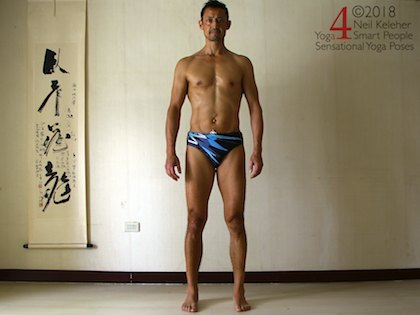
Thighs Neutral
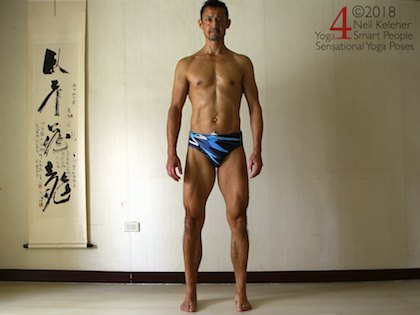
Thighs Externally Rotated
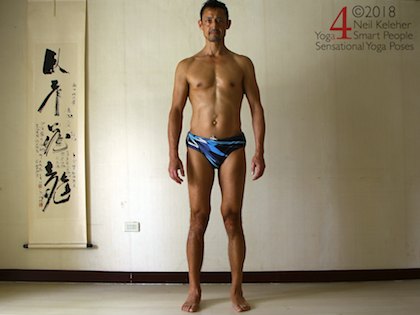
Thighs Internally Rotated
Something else that you can do when rotating your thighs is to rotate your feet along with your thighs. You could think of this as adjusting the rotation of your whole leg.
If you rotate only your thighs while standing you can notice that with external rotation the inner arches of your feet tend to lift while with internal rotation they moved towards a collapsed position.
With whole leg rotation, you can maintain the shape of your foot because your are turning your thigh, shin and foot together as one unit.
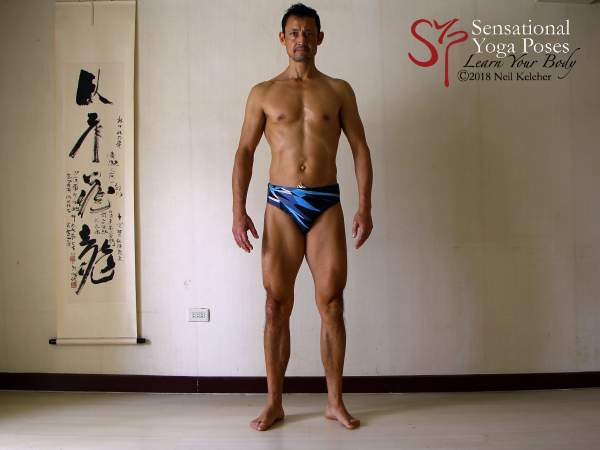
Legs rotated externally.
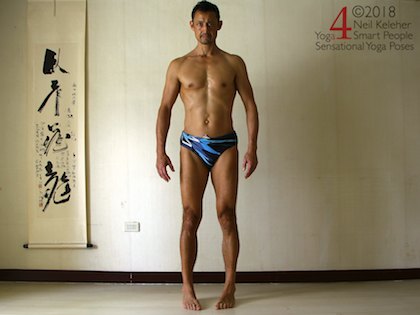
Legs rotated internally.
Another option is to adjust the positioning of your pelvis.
In this case one or both thighs are fixed and you adjust the position of your pelvis relative to your thighs.
- This can mean tilting it forwards or backwards.
- It can mean tilting from one side to the other (so that one hip is higher or lower or both hips are level).
- It can also mean turning the pelvis left or right.
Adjusting Forwards/Rearwards tilt of the pelvis.
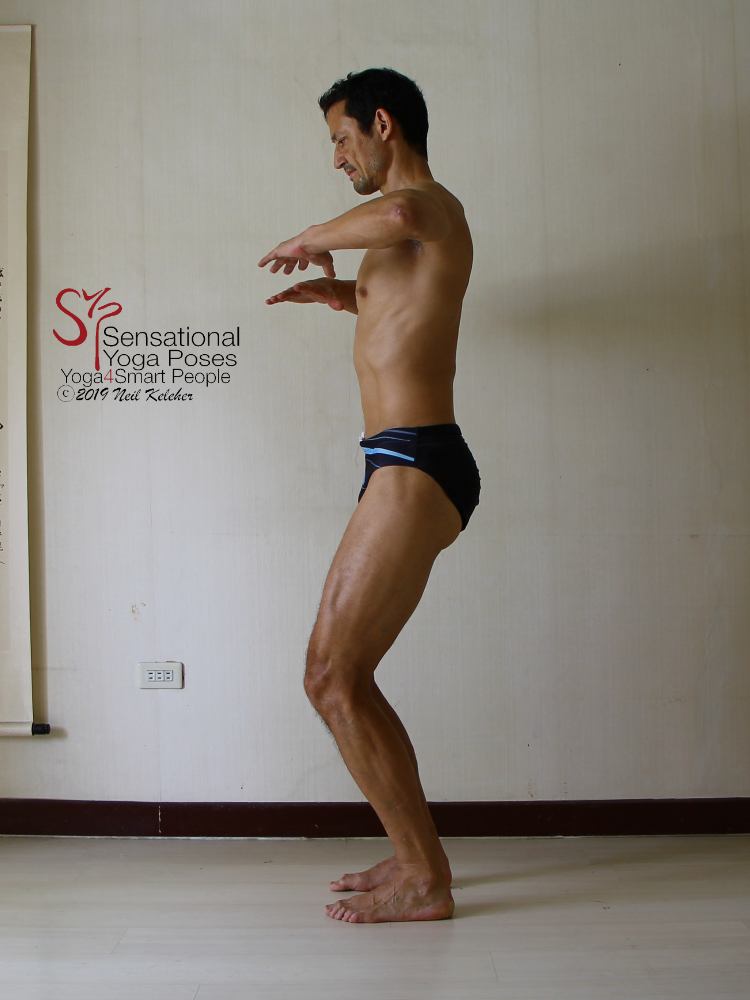
Neutral pelvic tilt (somewhere between a forward and backward tilt!)
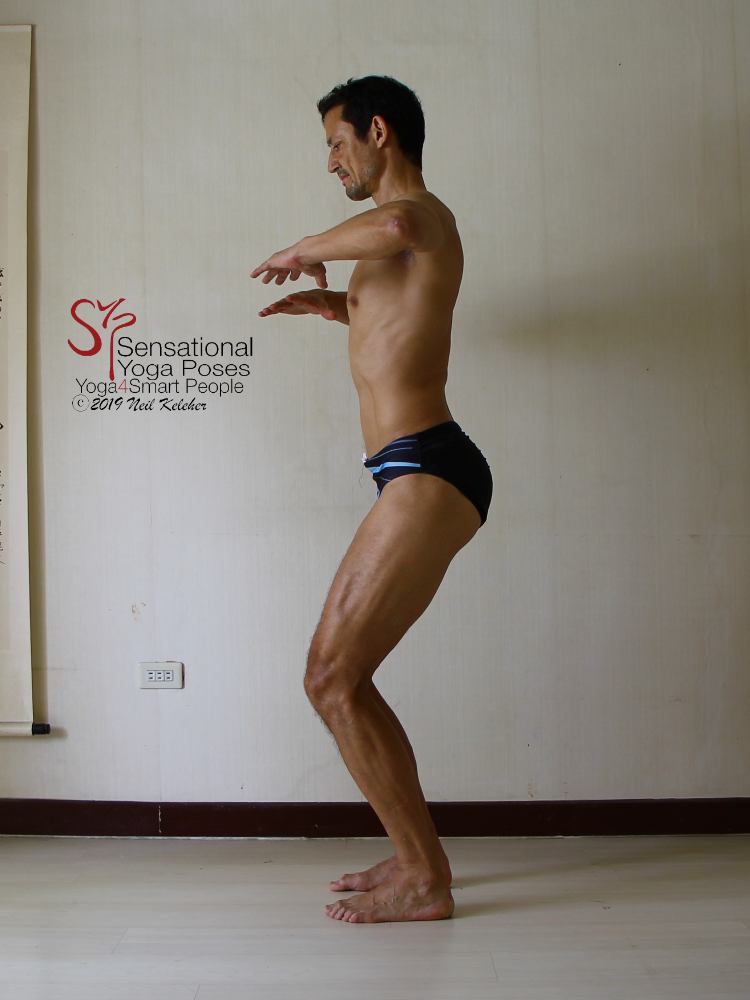
Forward pelvic tilt (increasing lumbar lordosis or "back bend")
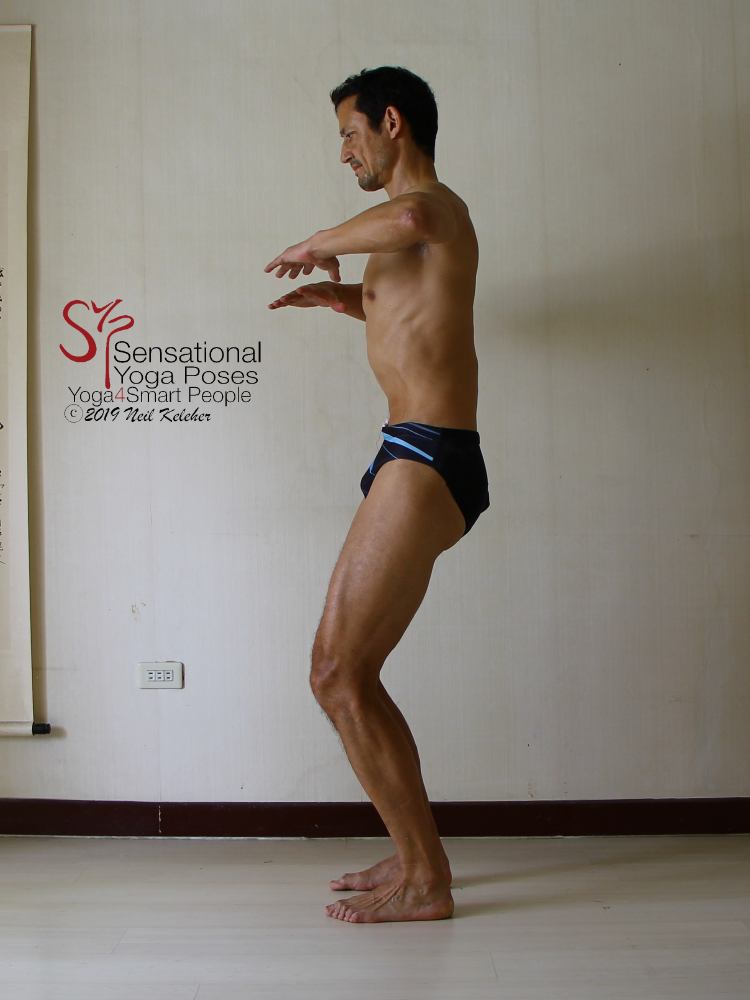
Rearward pelvic tilt (decreasing or flattening lumbar lordosis)
The hand position in the above photos is so that you can easily seem my pelvis and lumbar spine!
Adjusting "Lateral" or "Sideways" pelvic tilt.
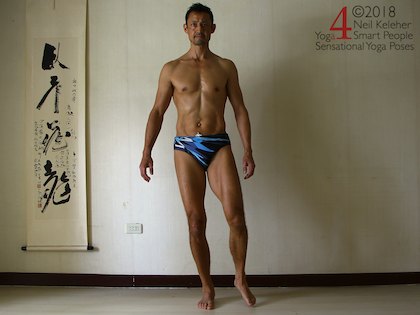
Relatively neutral lateral tilt (doesn't have to be perfectly level, though it can be)
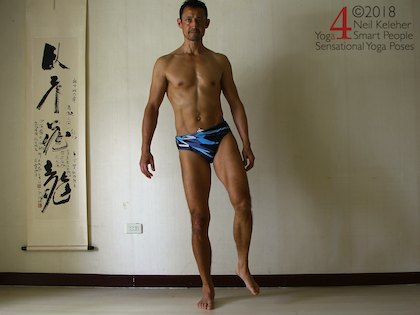
Unweighted hip lifted.
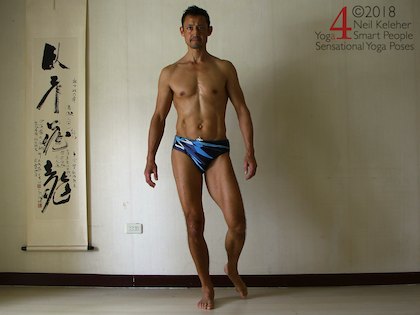
Unweighted hip dropped.
When tilting your pelvis laterally while standing on both legs, pick one of your legs as a reference leg.
Adjusting pelvic "Rotation".
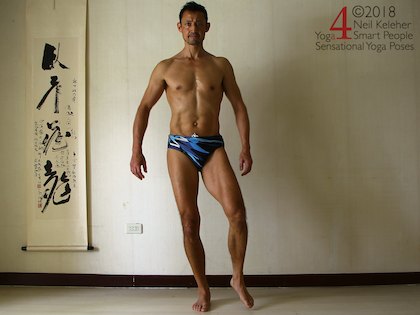
Neutral
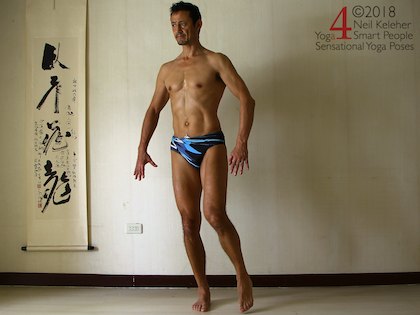
Pelvis turned towards standing leg side
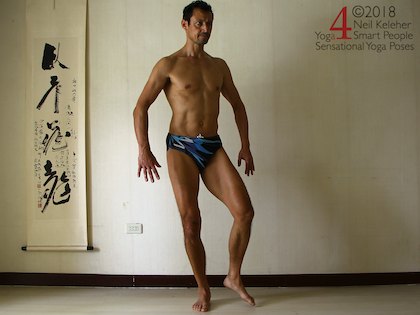
Pelvis turned away from standing leg side
When adjusting pelvic rotation while standing on both legs, again pick one of your legs as a reference.
Something else that can affect the "feel" of your hip joints (as well as other joints) is how your center of gravity is positioned relative to your foundation. You can play with shifting your weight laterally relative to your feet and also longitudinally in "front-to-back" direction.
Weight shifting from front to back
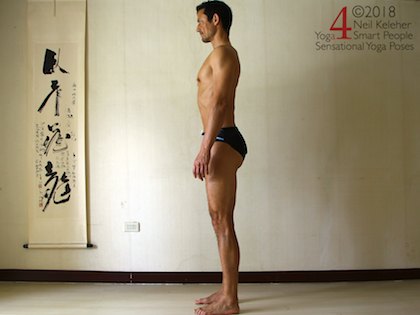
Neutral
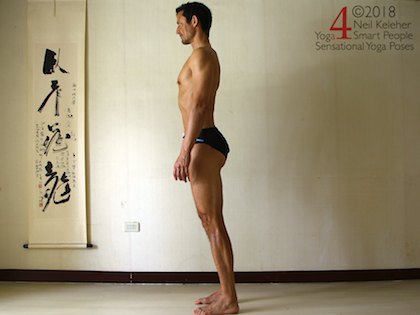
Weight Forwards (towards fronts of feet)
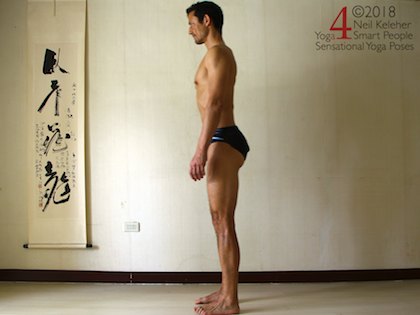
Weight Rearwards (towards heels)
Try learning to feel when your weight is over your forefeet, when it is over your heels and when it is even between both.
Weight Shifting left and right.
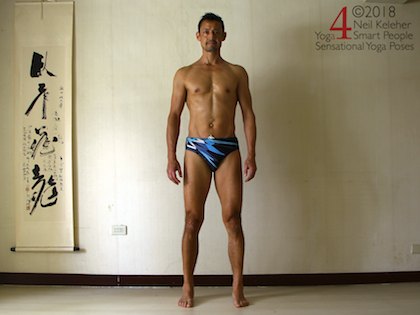
Neutral
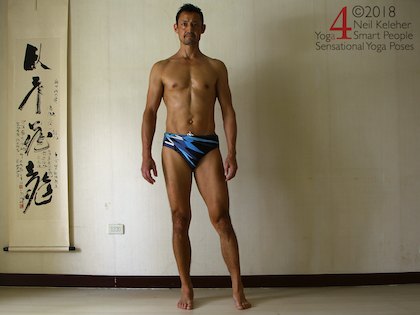
Weight towards right foot
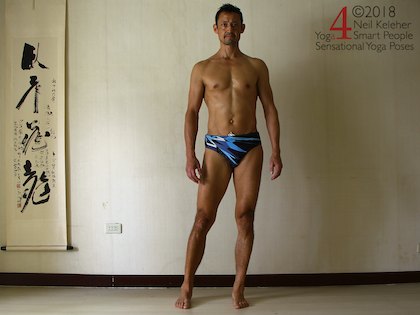
Weight towards left foot
Learn to feel when your weight is completely over one foot and when it is even on both feet.
When making any adjustments, and that generally involves a little bit of playing around, say by repeatedly rotating your thighs inwards and then outwards a few times in order to get an idea of which position feels best, limit yourself to one conscious adjustment at a time. So for example, when adjusting thigh rotation do just that. Your pelvis will probably change tilt at the same time. Let it. Focus on controlling your thigh rotation and notice the changes in sensation in your hip joints.
As you get better at feeling your body and controlling it, the adjustments will become second nature. If you still experience pain or discomfort despite your adjustments, you may need to look at experimenting with direct or conscious muscle control.
Consciously turning muscles on and off (muscle control) is another way of adjusting your yoga poses. It's also a way of getting a better feel for your body since muscles are the engines not only of movement and stability, but also the engines of sensation.
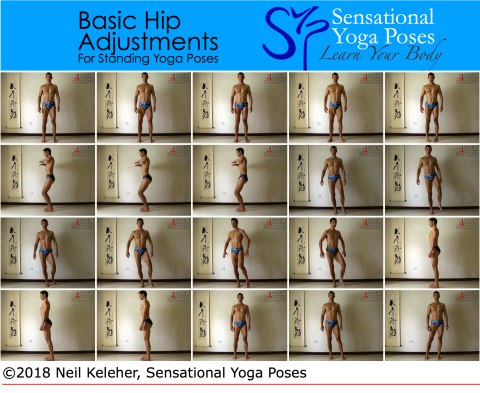
Published: 2020 08 04
Updated: 2021 02 11
Basic Hip Adjustments for Standing Yoga Poses
Return to TOP of Page























